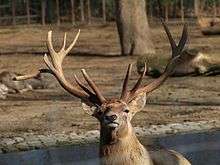Bactrian deer
| Bactrian deer | |
|---|---|
 | |
| Male (Stag) | |
| Scientific classification | |
| Kingdom: | Animalia |
| Phylum: | Chordata |
| Class: | Mammalia |
| Order: | Artiodactyla |
| Family: | Cervidae |
| Subfamily: | Cervinae |
| Genus: | Cervus |
| Species: | C. elaphus |
| Subspecies: | C. e. bactrianus |
| Trinomial name | |
| Cervus elaphus bactrianus Lydekker, 1900 | |
The Bactrian deer (Cervus elaphus bactrianus), also called the Bukhara deer, Bokhara deer or Bactrian wapiti, is a lowland subspecies of red deer that is native to Central Asia. It is similar in ecology to the Yarkand deer in occupying riparian corridors surrounded by deserts. Both subspecies are separated from one another by the Tian Shan Mountains and probably form a primordial subgroup of red Deer.
Description
This deer is usually ashy-gray with yellowish sheen, and a grayish white rump patch. It also has a slightly marked dorsal stripe and a white margin of the upper lip, lower lip, and chin. The antlers are light in color. There are usually four tines, with the absence of bez tine. The fourth tine is better developed than the third. Full grown individuals, however, have five tines on each antler with a bend after the third tine that is characteristic of most Central Asian red deer subspecies.
In contrast to the Yarkand deer, which has a light sandy coat, the Bactrian deer has a darker, grayish-brown coat pattern with darker legs, head, and neck (most noticeable in males) that resembles the coat of the American elk or wapitis, which is why this subspecies is sometimes called the Bactrian wapiti. These deer do not have neck manes, but do have stronger and thicker neck muscles than female deer that may give the appearance of a neck mane. Female deer are slightly smaller than male deer, but the difference in size is not as pronounced as it is in the European red deer subspecies.
Bactrian deer have, like Yarkand deer, short tails similar to the short tails of wapitis. The calves are generally born spotted much like European red deer calves, and most individuals lose their spots by adulthood. However, adult Bactrian deer may have a few spots on the backs of their summer coats. This phenomenon has also been observed in summer coats of the distantly related Manchurian wapiti (Cervus canadensis xanthopygus) and many other subspecies of red deer (Cervus elaphus).
Range
This deer is found in central Khorasan. It is found in Russian Turkestan (West Turkestan) and adjacent areas in northern Afghanistan to the west of the Tian Shan Mountains. Bactrian deer live in lowland riparian corridors of mixed deciduous (willow/poplar) vegetation surrounded by deserts. They do not migrate but may disperse into adjacent desert areas at night or at times of cooler temperatures.
Population
By 1999 there were not more than 400 Bukhara deer. The population diminished most drastically in Tajikistan because of military conflicts. However, since then, environmental organizations have taken steps to save the species. Moreover, World Wide Fund for Nature (WWF) implemented a reintroduction programme to bring Bukhara deer back to the places which it had once inhabited. For example, Bactrian deer have been reintroduced in Zarafshan reserve in Uzbekistan. As a result, in 2006 there were about 1,000 deer in Central Asia.[1] The largest wild populations were found in 2009 in Karatchingil Nature Reserve (320-350 animals) in the neighborhood of Altyn-Emel National Park in Kazakhstan, in Badai Tugai Nature Reserve (374 animals) in Uzbekistan, and in Tigrovaya Balka Nature Reserve (>150 animals) in Tadjikistan. The total wild population is 1430 and increasing.[2]
Conservation
Under the auspices of the Convention on Migratory Species of Wild Animals (CMS), also known as the Bonn Convention, the Memorandum of Understanding (MoU) concerning Conservation and Restoration of the Bukhara Deer was concluded and came into effect on 16 May 2002.[3] Acknowledging that the Bukhara deer faces threat of extinction as a result of human activities, the MoU provides an intergovernmental framework for governments, scientists and other groups to monitor and coordinate ongoing conservation efforts.
Predators
Aside from man, the wolf is probably the most dangerous of predators that most Central Asian red deer encounter. Occasionally, the brown bear will prey on these deer as well. Other possible predators are dholes and snow leopards. Eurasian lynx and wild boars sometimes prey on the calves. In the past they were also hunted by the now extinct Caspian tiger.
References
- ↑
- ↑ Large Herbivore Network: Bukhara Deer - Cervus elaphus bactrianus.
- ↑ http://www.cms.int/species/bukhara_deer/bukhara_deer_intro.htm